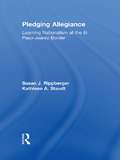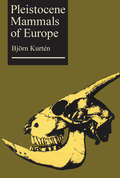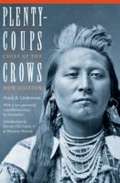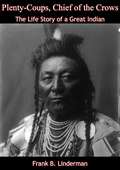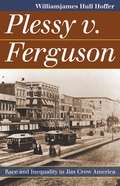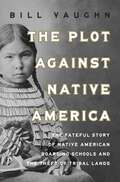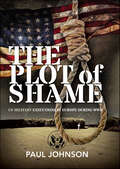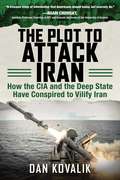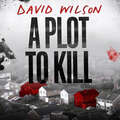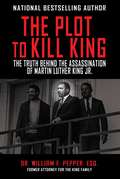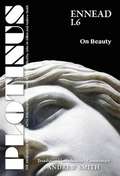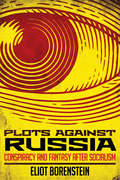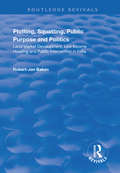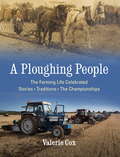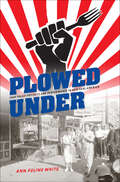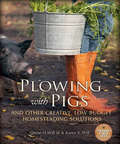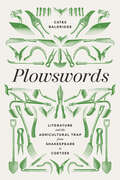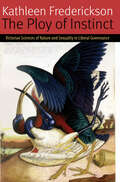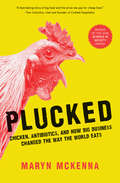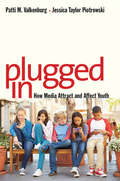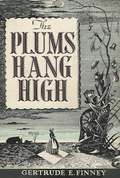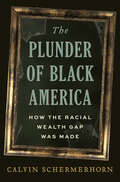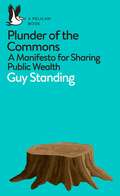- Table View
- List View
Pledging Allegiance: Learning Nationalism at the El Paso-Juarez Border
by Susan J. Rippberger Kathleen A. StaudtOffering a critical ethnography of education at the U.S.-Mexico border, Pledging Allegiance explores how public schools teach cultural and national values explicitly and implicitly. Susan J. Rippberger and Kathleen A. Staudt illuminate the complex overlays of culture and learning through the eyes of students, teachers, and administrators in U.S. and Mexican schools. This book examines nationalism and civic ritual, bilingualism, technology, and classroom organization to discover how educators along the border impart senses of national and cultural identity to their students.
Pleistocene Mammals of Europe
by Bjorn KurtenThis book provides a comprehensive treatment of all the Pleistocene species in Europe, classified according to modern taxonomic principles. For each species there is a description of its descent and migration history, its range, and its mode of life. The first version of this book was a semipopular paperback in the Swedish Aldus series.
Plenty-coups: Chief of the Crows
by Frank B. LindermanIn his old age, Plenty-coups (1848-1932), the last hereditary chief of the Crow Indians, told the moving story of his life to Frank B. Linderman, the well-known western writer who had befriended him.
Plenty-Coups, Chief of the Crows: The Life Story of a Great Indian
by Frank B. LindermanIn his old age, Plenty-Coups (1848-1932), the last hereditary chief of the Crow Indians, told the moving story of his life to Frank B. Linderman, a well-known western writer who had befriended him.First published in 1930, Plenty-Coups is a classic account of the nomadic, spiritual, and warring life of Plains Indians before they were forced onto reservations. Plenty-Coups tells of the great triumphs and struggles of his own life: his powerful medicine dreams, marriage, raiding and counting coups against the Lakotas, fighting alongside the U.S. Army, and the death of General Custer.
Plessy V. Ferguson: Race And Inequality In Jim Crow America
by WilliamJames Hull HofferSix decades before Rosa Parks boarded her fateful bus, another traveler in the Deep South tried to strike a blow against racial discrimination--but ultimately fell short of that goal, leading to the Supreme Court's landmark 1896 decision in Plessy v. Ferguson. Now Williamjames Hull Hoffer vividly details the origins, litigation, opinions, and aftermath of this notorious case. In response to the passage of the Louisiana Separate Car Act of 1890, which prescribed "equal but separate accommodations" on public transportation, a group called the Committee of Citizens decided to challenge its constitutionality. At a pre-selected time and place, Homer Plessy, on behalf of the committee, boarded a train car set aside for whites, announced his non-white racial identity, and was immediately arrested. The legal deliberations that followed eventually led to the Court's 7-1 decision in Plessy, which upheld both the Louisiana statute and the state's police powers. It also helped create a Jim Crow system that would last deep into the twentieth century, until Brown v. Board of Education in 1954 and other cases helped overturn it. Hoffer's readable study synthesizes past work on this landmark case, while also shedding new light on its proceedings and often-neglected historical contexts. From the streets of New Orleans' Faubourg Trem district to the justices' chambers at the Supreme Court, he breathes new life into the opposing forces, dissecting their arguments to clarify one of the most important, controversial, and socially revealing cases in American law. He particularly focuses on Justice Henry Billings Brown's ruling that the statute's "equal, but separate" condition was a sufficient constitutional standard for equality, and on Justice John Marshall Harlan's classic dissent, in which he stated, "Our Constitution is color-blind, and neither knows nor tolerates classes among its citizens. " Hoffer's compelling reconstruction illuminates the controversies and impact of Plessy v. Ferguson for a new generation of students and other interested readers. It also pays tribute to a group of little known heroes from the Deep South who failed to hold back the tide of racial segregation but nevertheless laid the groundwork for a less divided America.
The Plot Against Native America: The Fateful Story of Native American Boarding Schools and the Theft of Tribal Lands
by Bill VaughnThe first narrative history revealing the entire story of the development, operation, and harmful legacy of the Native American boarding schools—and how our nation still has much to resolve before we can fully heal.When Europeans came to the Americas centuries ago, too many of them brought racism along with them. Even presidents such as George Washington, Thomas Jefferson, and Andrew Jackson each had different takes on how to solve the &“Indian Problem&”—none of them beneficial for the Natives. In the early 1800s, the federal government and various church denominations devised the &“Indian Boarding Schools,&” in which Native children were forced to give up their Native languages, clothes, and spiritual beliefs for a life of cultural assimilation. Many of the children were abused sexually—and a shocking number died of pneumonia, tuberculosis, and other diseases. Sizable graveyards were found at many of these boarding schools. In 2021, the mass graves of First Nations children were found at the remains of some Canadian boarding schools, and the Pope traveled to Canada to apologize. In May 2022, U.S. Secretary of the Interior Deb Haaland released the first installment of an investigation into Native American boarding schools in the United States. It was the tip of the iceberg. The findings were shocking: the investigation revealed that the boarding school system emphasized manual labor and vocational training, which failed to prepare indigenous students for life in a capitalist economy. Despite the plot against Native America, tribal cultures have endured and are now flourishing. Indigenous birth rates are higher than those of white communities. Tribal councils across Indian Country are building their own herds of bison. As the tribes rebuild and reinvigorate their culture, the Catholic Church in America is fading. Some thirty dioceses have declared bankruptcy because of lawsuits brought by the victims of the sexual predators among priests and nuns. Native Americans seeking reparations for lost land are looking directly at the Vatican.
The Plot of Shame: US Military Executions in Europe During WWII
by Paul JohnsonThe Oise-Aisne American Cemetery is the last resting place of 6,012 American soldiers who died fighting in a small portion of Northern France during the First World War. The impressive cemetery is divided into four plots marked A to D. However, few visitors are aware that across the road, behind the immaculate façade of the superintendent’s office, unmarked and completely surrounded by impassable shrubbery, is Plot E, a semi-secret fifth plot that contains the bodies of ninety-four American soldiers. These were men who were executed for crimes committed in the European Theater of Operations during and just after the Second World War. Originally, the men whose death sentences were carried out were buried near the sites of their executions in locations as far afield as England, France, Belgium, Germany, Italy, and Algeria. A number of the men were executed in the grounds of Shepton Mallet prison in Somerset – the majority of whom were hanged in the execution block, with two being shot by a firing squad in the prison yard. The executioner at most of the hangings was Thomas William Pierrepoint, assisted mainly by his more-famous nephew Albert Pierrepoint. Then, in 1949, under a veil of secrecy, the ‘plot of shame’, as it has become known, was established in France. The site does not exist on maps of the cemetery and it is not mentioned on the American Battle Monuments Commission’s website. Visits to Plot E are not encouraged. Indeed, public access is difficult because the area is concealed, surrounded by bushes, and is closed to visitors. No US flag is permitted to fly over the plot and the graves themselves have no names, just small, simple stones the size of index cards that are differentiated only by reference numbers. Even underground the dishonored are set apart, with each body being positioned with its back to the main cemetery. In The Plot of Shame, the historian Paul Johnson uncovers the history of Plot E and the terrible stories of wartime crime linked to it.
The Plot to Attack Iran: How the CIA and the Deep State Have Conspired to Vilify Iran
by Dan Kovalik* “Spectacular!” * –Oliver StoneThe world has a lot of questions about the current state of affairs between the United States and Iran… How has the US undermined democracy in Iran? Is Iran really trying to develop nuclear weapons? How has US waged a terror campaign against Iran for years? How is it that the US and Israel, rather than Iran, are destabilizing the Middle East? How has Iran helped the US in the war on terror?In The Plot to Attack Iran, critically acclaimed author Dan Kovalik exposes what Americans have known about the Islamic Republic is largely based on propaganda. The 1953 coup that deposed the democratically-elected prime minister for a US-selected shah? Sold to average American citizens as a necessity to protect democracy and guard against communism. In truth, it was America’s lust for Iranian oil and power that installed the tyrannical shah. The Iranian hostage crisis that miraculously ended with Ronald Reagan’s inauguration as president? Evidence shows that Reagan negotiated with the hostage-takers to hold the hostages until his inauguration.Iran, once known as Persia, is one of the oldest nations on earth. It has a rich history and a unique culture, and is bordered by seven countries, the Caspian Sea, and the Persian Gulf. It is literally the intersection of many countries and many worlds. It has a population of eighty million people and occupies a space nearly the size of Alaska, the largest US state; it is the seventeenth largest country in the world. Over the past century, Iran’s greatest resource, and at the same time its greatest curse, has been its oil. For it is oil that has caused the United States and other world powers to systematically attempt to destroy Iran. After a greedy Iranian monarch sold all of Iran’s oil and natural gas reserves to a British financier in 1901, the West started just one of its many invasions and exploitations of the country.Using recently declassified documents and memos, as well as first-hand experience of the country, critically-acclaimed author Dan Kovalik will change the way you think about Iran, and especially what you think of US interference there. Learn how the United States vilifies its enemies, and accuses them of unspeakable horror to mask its own terrible crimes. Not only does the illuminating and important The Plot to Attack Iran delve into the current incendiary situation, but it also predicts what could happen next, and what needs to be done before it is too late.
A Plot to Kill: A true story of deception, betrayal and murder in a quiet English town
by David Wilson'[A] real-life Midsomer Murder ... it's chilling, but [David Wilson's] explanation of how a psychopath thinks is masterly' The TimesThe shocking story of the murder of Peter Farquhar and the churchwarden who groomed and betrayed him, from the UK's leading criminologist David WilsonTwo deaths.Three doors apart.An unsuspecting community about to realise there's a killer in their midst. In October 2015, Peter Farquhar was found dead in his house in Maids Moreton, lying on the sofa next to a bottle of whisky. An inquest was made, and Peter's death was quickly ruled an accident.But after the death of another elderly neighbour, the dreadful truth began to emerge: both victims had been groomed, seduced and mentally tortured by a young man, Benjamin Field, who had used his position of power in the community to target and exploit the elderly.He almost got away with it. Very little shocks criminologist David Wilson, but this extraordinary case in his sleepy hometown astounded him. Wilson felt duty-bound to follow its trail, discovering how his tightknit community failed to intervene, how a psychopath went undetected for years, and how Peter unwittingly supplied the blueprint for his own murder.A Plot to Kill is a chilling, gripping account of a callous murder in the heart of middle England, a fight for justice, and a revealing insight into the mind of a killer.
A Plot to Kill: The notorious killing of Peter Farquhar, a story of deception and betrayal that shocked a quiet English town
by David Wilson'[A] real-life Midsomer Murder ... it's chilling, but [David Wilson's] explanation of how a psychopath thinks is masterly' The TimesThe shocking story of the murder of Peter Farquhar and the churchwarden who groomed and betrayed him, from the UK's leading criminologist David WilsonTwo deaths.Three doors apart.An unsuspecting community about to realise there's a killer in their midst. In October 2015, Peter Farquhar was found dead in his house in Maids Moreton, lying on the sofa next to a bottle of whisky. An inquest was made, and Peter's death was quickly ruled an accident.But after the death of another elderly neighbour, the dreadful truth began to emerge: both victims had been groomed, seduced and mentally tortured by a young man, Benjamin Field, who had used his position of power in the community to target and exploit the elderly.He almost got away with it. Very little shocks criminologist David Wilson, but this extraordinary case in his sleepy hometown astounded him. Wilson felt duty-bound to follow its trail, discovering how his tightknit community failed to intervene, how a psychopath went undetected for years, and how Peter unwittingly supplied the blueprint for his own murder.A Plot to Kill is a chilling, gripping account of a callous murder in the heart of middle England, a fight for justice, and a revealing insight into the mind of a killer.
The Plot to Kill King: The Truth Behind the Assassination of Martin Luther King Jr.
by Esq. William F. PepperWilliam Pepper was James Earl Ray’s lawyer in the trial for the murder of Martin Luther King, Jr., and even after Ray’s conviction and death, Pepper continues to adamantly argue Ray’s innocence. This myth-shattering expose is a revised, updated, and heavily expanded volume of Pepper’s original best-selling and critically-acclaimed book of the same name, with twenty-six years of additional research included. The result reveals dramatic new details of the night of the murder, the trial, and why Ray was chosen to take the fall for an evil conspiracy-a government-sanctioned assassination of our nation’s greatest leader.Orders to Kill will release in sync with a feature film adaptation of it that will be directed by Lee Daniels, have Hugh Jackman star as the author, and be produced by Millennium Films. The film will portray Pepper in trial and his proof of an assassination plot masterminded by J. Edgar Hoover and the FBI, the CIA, army intelligence, the mafia, and Memphis police. The plan, according to Pepper, was for a team of United States Army Special Forces snipers to kill King, but just as they were taking aim, a back-up civilian assassin pulled the trigger.In Orders to Kill, Pepper shares the evidence and testimonies that prove that Ray was a fall-guy chosen by those who viewed King as a dangerous revolutionary. His findings make the book one of the most important ones of our time-the uncensored story of the murder of an American hero and disturbing revelations about secret under-workings of the government and how it continues, even today, to obscure and obfuscate the truth.Skyhorse Publishing, as well as our Arcade imprint, are proud to publish a broad range of books for readers interested in history--books about World War II, the Third Reich, Hitler and his henchmen, the JFK assassination, conspiracies, the American Civil War, the American Revolution, gladiators, Vikings, ancient Rome, medieval times, the old West, and much more. While not every title we publish becomes a New York Times bestseller or a national bestseller, we are committed to books on subjects that are sometimes overlooked and to authors whose work might not otherwise find a home.
PLOTINUS Ennead I.6: Translation with an Introduction and Commentary
by Andrew SmithEnnead I.6 is probably the best known and most influential treatise of Plotinus, especially for Renaissance artists and thinkers. Although the title may suggest a work on aesthetics and thus of limited focus, this is far from the case. For it quickly becomes apparent that Plotinus’ main interest is in transcendent beauty, which he identifies with the Good, the goal of all philosophical endeavor in the Platonist’s search to assimilate himself with the divine. <p><p> The treatise is at once a philosophical search for the nature of the divine and at the same time an encouragement to the individual to aspire to this goal by taking his start from the beauty which is experienced in this world; for it is an image of transcendent beauty. This upward movement of the treatise reflects throughout the speech of Socrates in Plato’s Symposium in which he recounts the exhortation of the priestess Diotima to ascend from earthly to transcendent beauty, which for Plotinus is identified with the divine.
Plots against Russia: Conspiracy and Fantasy after Socialism
by Eliot BorensteinIn this original and timely assessment of cultural expressions of paranoia in contemporary Russia, Eliot Borenstein samples popular fiction, movies, television shows, public political pronouncements, internet discussions, blogs, and religious tracts to build a sense of the deep historical and cultural roots of konspirologiia that run through Russian life. Plots against Russia reveals through dramatic and exciting storytelling that conspiracy and melodrama are entirely equal-opportunity in modern Russia, manifesting themselves among both pro-Putin elites and his political opposition. As Borenstein shows, this paranoid fantasy until recently characterized only the marginal and the irrelevant. Now, through its embodiment in pop culture, the expressions of a conspiratorial worldview are seen everywhere. Plots against Russia is an important contribution to the fields of Russian literary and cultural studies from one of its preeminent voices.
Plotting, Squatting, Public Purpose and Politics: Land Market Development, Low Income Housing and Public Intervention in India (Routledge Revivals Ser.)
by Robert Jan BakenThis title was first published in 2003. Since independence in 1947, India has undergone a phase of rapid urbanization. New planning laws have been passed, new organizations established, public policy documents and discussion papers prepared and a host of land and housing schemes have been implemented. Still, however, the vast majority of urban expansion is an unplanned process that takes the form of squatting and illegal or semi-legal land subdivision. By looking in detail at two rapidly growing cities in Andhra Pradesh (Vijayawada and Viaskhapatnam) this book explores cultural, physical-spatial, political and economic determinants of the allocation of urban land and of urban growth in India in historical context. It focuses on the interplay between the government and the organizations in charge of their implementation, and the private sector on the other. Special attention is given to the conditions of the urban poor, with the changes in their socio-economic conditions.
A Ploughing People: The Farming Life Celebrated - Stories, Traditions, The Championships
by Valerie CoxJourney into the heartland of rural Ireland, in words and images, from the 1930s to today. Meet the characters behind the Ploughing Championships, past and present. Witness the traditions and stories from a changing way of life, where community spirit remains central, and the plough keeps turning the sod, year on year . . .Since the early 1930s, The National Ploughing Championships has occupied a special place in the heart of ruralIrish life, when people gather from every corner of the country to show off their skills and engage in sport, fun and business. Here, for the first time, the magic of the Ploughing is captured in word and image. We follow Valerie Cox as she journeys around Ireland to meet the people who make this national institution great, and record the stories of what the ploughing means to them, whether it's vintage tractors, a pair of Clydesdales or a plough handed down from a grandfather.Among others, we meet three-time world champion Martin Keogh, take an unforgettable trip to Thady Kelleher country in East Cork, and are enchanted by the first even Queen of the Plough Anna Mai Donegan, who won her crown in 1955.This beautiful book also provides a record of a landscape that may bear little resemblance to that of the 1930s but, in important ways - of family, community and the nod and wink of the business deal - is little changed. A gift, a keepsake, A Ploughing People is a unique celebration of the best of Irish life.
Plowed Under: Food Policy Protests and Performance in New Deal America
by Ann Folino WhiteA study of Depression-era anger at food waste: “An invaluable contribution to history, theater history, cultural studies, American studies, and other fields.” —Journal of American HistoryDuring the Great Depression, with thousands on bread lines, farmers were instructed by the New Deal Agricultural Adjustment Act to produce less food in order to stabilize food prices and restore the market economy. Fruit was left to rot on trees, crops were plowed under, and millions of piglets and sows were slaughtered and discarded. Many Americans saw the government action as a senseless waste of food that left the hungry to starve, initiating public protests against food and farm policy.Ann F. White approaches these events as performances where competing notions of morality and citizenship were acted out, often along lines marked by class, race, and gender. The actions range from the “Milk War” that pitted National Guardsmen against dairymen who were dumping milk, to the meat boycott staged by Polish-American women in Michigan, and from the black sharecroppers’ protest to restore agricultural jobs in Missouri to the protest theater of the Federal Theater Project. White provides a riveting account of the theatrical strategies used by consumers, farmers, agricultural laborers, and the federal government to negotiate competing rights to food and the moral contradictions of capitalist society in times of economic crisis.
Plowing with Pigs and Other Creative, Low-Budget Homesteading Solutions
by Karen K. Will Oscar H. WillFueled by a failing economy and a passionate desire for a return to simpler times, a new wave of homesteaders is seeking the good life and the kind of true satisfaction that can only be built, not bought. Many of these modern pioneers are cash poor, but rich in energy and creativity. Plowing with Pigs and Other Creative, Low-Budget Homesteading Solutions offers them a set of fresh ideas for achieving independence through sweat equity and the use of unconventional resources. This highly readable and entertaining guide brings together answers to common problems faced by homesteaders young and old, urban, suburban, and rural. Traditional knowledge is combined with MacGyver-style ingenuity to create projects that maximize available resources, including: Animal management strategies for the yard, garden, and field Pole building and construction techniques from woodlot materials Replacing farm machinery with homemade hand tools and implements Leveraging increased self-sufficiency into a home-based business Whether you are a dreamer or a doer, Plowing with Pigs will inspire, challenge, and enable you to do more with less (and have fun doing it). Oscar H. (Hank) Will III is a farmer, scientist, and author, known for seeking and implementing creative farmstead solutions. The editor of Grit magazine, Hank has published hundreds of articles and five books on a range of topics including antique farm machinery. Karen K. Will is editor of The Heirloom Gardener magazine and author of Cooking with Heirlooms: Seasonal Recipes with Heritage-Variety Vegetables and Fruits. She operates Prairie Turnip Farm with her husband Oscar H. Will III.
Plowswords: Literature and the Agricultural Trap from Shakespeare to Coetzee
by Cates BaldridgeA critical examination of the &‘agricultural trap&’ in literature For thousands of years, agriculture and civilization were essentially synonymous. The superiority of farming over the unsettled, itinerant life of hunting and gathering appeared, to many, self-evident. Only recently has the field of anthropology challenged this assumption by positing that foragers were, and are, actually happier and healthier than people living in agro-cultures. Plowswords is the first work to consider the refiguring of the agricultural revolution into the agricultural trap through a literary lens. Reading texts that depict farmers in conflict with foragers, Cates Baldridge argues that agricultural ideology justified the tedium and toil of farming by enlisting a rhetorical foil: the &“savage&” and &“backward&” hunter-gatherer. Texts such as The Tempest, Robinson Crusoe, Frankenstein, Wuthering Heights, Heart of Darkness, and the novels of J. M. Coetzee use this figure either to exalt farming&’s triumph over foraging or to mourn the consequences of the agricultural turn, anxiously championing or stridently challenging the received wisdom of humanity&’s supposed progress.
The Ploy of Instinct: Victorian Sciences of Nature and Sexuality in Liberal Governance (Forms of Living)
by Kathleen FredericksonIt is paradoxical that instinct became a central term for late Victorian sexual sciences as they were elaborated in the medicalized spaces of confession and introspection, given that instinct had long been defined in its opposition to self-conscious thought. The Ploy of Instinct ties this paradox to instinct’s deployment in conceptualizing governmentality.Instinct’s domain, Frederickson argues, extended well beyond the women, workers, and “savages” to whom it was so often ascribed. The concept of instinct helped to gloss over contradictions in British liberal ideology made palpable as turn-of-the-century writers grappled with the legacy of Enlightenment humanism. For elite European men, instinct became both an agent of “progress” and a force that, in contrast to desire, offered a plenitude in answer to the alienation of self-consciousness.This shift in instinct’s appeal to privileged European men modified the governmentality of empire, labor, and gender. The book traces these changes through parliamentary papers, pornographic fiction, accounts of Aboriginal Australians, suffragette memoirs, and scientific texts in evolutionary theory, sexology, and early psychoanalysis.
Plucked: A History of Hair Removal (Biopolitics #8)
by Rebecca M. HerzigUncovers the history of hair removal practices and sheds light on the prolific culture of beautyFrom the clamshell razors and homemade lye depilatories used in colonial America to the diode lasers and prescription pharmaceuticals available today, Americans have used a staggering array of tools to remove hair deemed unsightly, unnatural, or excessive. This is true especially for women and girls; conservative estimates indicate that 99% of American women have tried hair removal, and at least 85% regularly remove hair from their faces, armpits, legs, and bikini lines. How and when does hair become a problem—what makes some growth “excessive”? Who or what separates the necessary from the superfluous? In Plucked, historian Rebecca Herzig addresses these questions about hair removal. She shows how, over time, dominant American beliefs about visible hair changed: where once elective hair removal was considered a “mutilation” practiced primarily by “savage” men, by the turn of the twentieth century, hair-free faces and limbs were expected for women. Visible hair growth—particularly on young, white women—came to be perceived as a sign of political extremism, sexual deviance, or mental illness. By the turn of the twenty-first century, more and more Americans were waxing, threading, shaving, or lasering themselves smooth. Herzig’s extraordinary account also reveals some of the collateral damages of the intensifying pursuit of hair-free skin. Moving beyond the experiences of particular patients or clients, Herzig describes the surprising histories of race, science, industry, and medicine behind today's hair-removing tools. Plucked is an unsettling, gripping, and original tale of the lengths to which Americans will go to remove hair.
Plucked: Chicken, Antibiotics, and How Big Business Changed the Way We Eat
by Maryn McKennaIn this eye-opening exposé, acclaimed health journalist and National Geographic contributor Maryn McKenna documents how antibiotics transformed chicken from local delicacy to industrial commodity—and human health threat—uncovering the ways we can make America's favorite meat safer again. What you eat matters—for your health, for the environment, and for future generations. In this riveting investigative narrative, McKenna dives deep into the world of modern agriculture by way of chicken: from the farm where it's raised directly to your dinner table. Consumed more than any other meat in the United States, chicken is emblematic of today's mass food-processing practices and their profound influence on our lives and health. Tracing its meteoric rise from scarce treat to ubiquitous global commodity, McKenna reveals the astounding role of antibiotics in industrial farming, documenting how and why "wonder drugs" revolutionized the way the world eats—and not necessarily for the better. Rich with scientific, historical, and cultural insights, this spellbinding cautionary tale shines a light on one of America's favorite foods—and shows us the way to safer, healthier eating for ourselves and our children. This book was previously published in hardcover with the title Big Chicken: The Incredible Story of How Antibiotics Created Modern Agriculture and Changed the Way the World Eats.
Plugged In: How Media Attract and Affect Youth
by Jessica Taylor Piotrowski Patti M. ValkenburgAn illuminating study of the complex relationship between children and media in the digital age Now, as never before, young people are surrounded by media—thanks to the sophistication and portability of the technology that puts it literally in the palms of their hands. Drawing on data and empirical research that cross many fields and continents, authors Valkenburg and Piotrowski examine the role of media in the lives of children from birth through adolescence, addressing the complex issues of how media affect the young and what adults can do to encourage responsible use in an age of selfies, Twitter, Facebook, and Instagram. This important study looks at both the sunny and the dark side of media use by today’s youth, including why and how their preferences change throughout childhood, whether digital gaming is harmful or helpful, the effects of placing tablets and smartphones in the hands of toddlers, the susceptibility of young people to online advertising, the legitimacy of parental concerns about media multitasking, and more.
The Plums Hang High
by Gertrude E. FinneyA young English couple sail to the new land where fortunes like plums are for the taking. But nothing has prepared Hannah Maria, who trusts in the comforts of her brother's home, for the crude life of a Midwest farm in 1868. Only a deep love and her proud spirit sustain her in early bitterness and despair.Jethro, with no experience on the land, wants to be a farmer. A kindly, hardworking couple take the tyros to their hearts. Some lessons are bitter, some laughable, as they become farmer folk. Their first farm turns out to be worthless and they must hire out again on shares. Tender and poignant is the tale of the dress washed out each night, of the two who ran away to see the circus and sold the family's valuable horse. In a great blizzard Jethro goes for nurse and doctor, returns to find a baby has been born without their help. At last Jethro is famous for his Clydesdales.They have an assured position and honors come.The Plums Hang High has a sense of the drama of life itself, of generation succeeding generation.
The Plunder of Black America: How the Racial Wealth Gap Was Made
by Calvin SchermerhornThe long history of the racial wealth gap in America told through the stories of seven Black families who struggled to build wealth over multiple generations Wealth is central to the American pursuit of happiness and is an overriding measure of well-being. Yet wealth is conspicuously absent from African American households. Why do some 3.5 million Black American families have zero or negative wealth? Historian Calvin Schermerhorn traces four hundred years of Black dispossession and decapitalization—what Frederick Douglass called plunder—through the stories of families who have strived to earn and keep the fruits of their toils. Their struggles reveal that the ever-evolving strategies to strip Black income and wealth have been critical to sustaining a structure of racialized disadvantage. These accounts also tell of the quiet heroism of those who worked to overcome obstacles and defy the plunder. From the story of Anthony and Mary Johnson, abducted from Angola and brought to Virginia in 1619, to the enslaved Black workers dispossessed by the Custis-Washington family, to Venture Smith (born Broteer Furro), who purchased his freedom, to three generations of a family enslaved in the South who moved north after Emancipation, to the Tulsa massacre and the subprime lending crisis, Schermerhorn shows that we cannot reckon with today&’s racial wealth inequality without understanding its unrelenting role in American history.
Plunder of the Commons: A Manifesto for Sharing Public Wealth (Pelican Books)
by Guy Standing'One of the most important books I've read in years' Brian EnoWe are losing the commons. Austerity and neoliberal policies have depleted our shared wealth; our national utilities have been sold off to foreign conglomerates, social housing is almost non-existent, our parks are cordoned off for private events and our national art galleries are sponsored by banks and oil companies. This plunder deprives us all of our common rights, recognized as far back as the Magna Carta and the Charter of the Forest of 1217, to share fairly and equitably in our public wealth.Guy Standing leads us through a new appraisal of the commons, stemming from the medieval concept of common land reserved in ancient law from marauding barons, to his modern reappraisal of the resources we all hold in common - a brilliant new synthesis that crystallises quite how much public wealth has been redirected to the 1% in recent decades through the state-approved exploitation of everything from our land to our state housing, health and benefit systems, to our justice system, schools, newspapers and even the air we breathe. Plunder of the Commons proposes a charter for a new form of commoning, of remembering, guarding and sharing that which belongs to us all, to slash inequality and soothe our current political instability.
